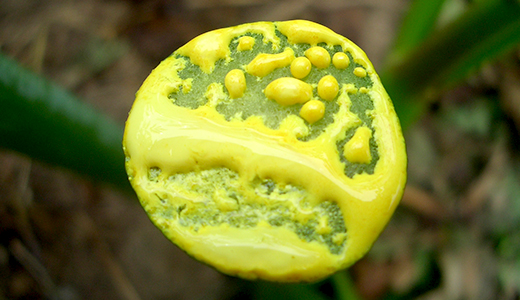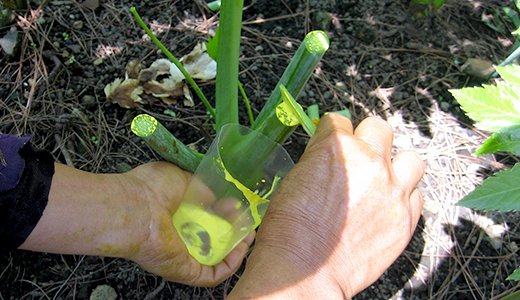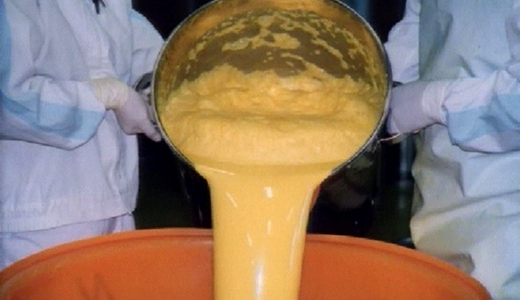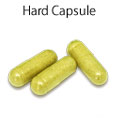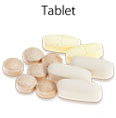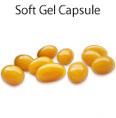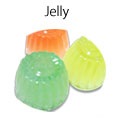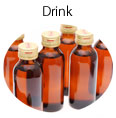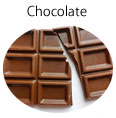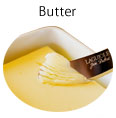Valuable Yellow Polyphenol Components Uniquely Found in Ashitaba
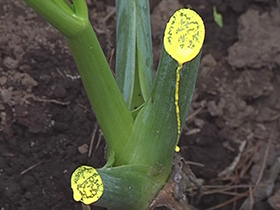
When the leaves and stems of Ashitaba are cut, viscous yellow sap comes out from the cut surface. This yellow sap is not found in any other Apiaceae plants, but found exclusively in Ashitaba. Only a few milligrams of this sap can be collected from one Ashitaba stem, which makes it very valuable.
Ashitaba polyphenols are plentifully contained in this yellow sap and are called chalcones. Over 10 types of chalcones are confirmed to exist in the yellow sap.
We are the first manufacturer in Japan which succeeded in powderising the Ashitaba polyphenols in 1999 and, consequently, introduced it as a new functional material. We have been studying its utility and functionality ever since.
- What is an Ashitaba Polyphenol “Chalcone”?
-
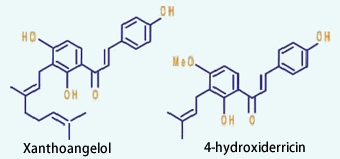
“Chalcones”, the main components of the Ashitaba polyphenols, are the polyphenols that have yellow flavonoid pigments, which are particularly rich in two types of chalcones, 4-hydroxiderricine and xanthoangelol, and their efficacy has been attracting much attention.
Fat Reduction Mechanism of Ashitaba Polyphenols
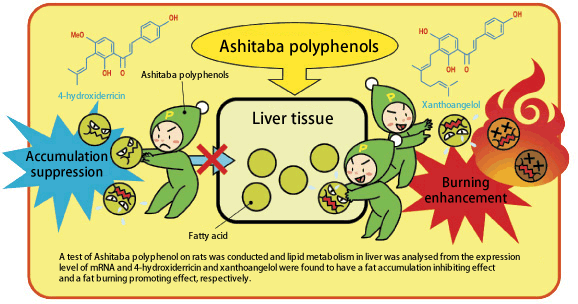
- Sap Collection
-
- Efficacy
-
・Anti-metabolic syndrome
- An adiponectin production promoting effect
- A promoting effect on leptin production in mice
- A reduction effect on visceral fat weight as well as an inhibiting effect on body weight gain in mice
- A reducing effect on the sectional area of the visceral fat from a human study

An Abdominal Fat Reducing Effect by Taking CHALSAP
Significant reductions in the abdominal total fat and the visceral fat area after 8 weeks of CHALSAP-P8 intake were observed.
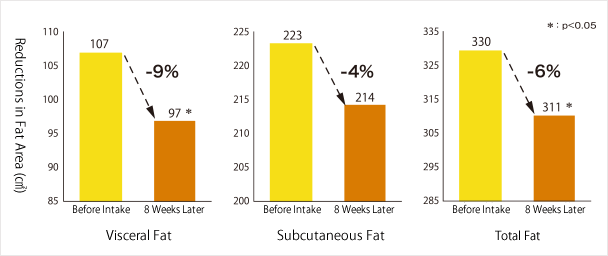
Reduction in Abdominal Fat Area by Taking CHALSAP ・An anti-bacterial effect
- An anti-bacterial effect on Helicobacter pylori (in vitro)
- An anti-bacterial effect on a heat-resistant acidophilic bacterium (Alicyclobacillus sp.)
・An anti-tumour effect
- An inhibitory effect on a carcinogenesis initiator/carcinogenesis promotor
- An apoptosis-inducing effect on cancer cells
- Cancer cytotoxic activity

・A production enhancing effect on Nerve Growth Factor (NGF、BDNF、GDNF)
・An antioxidant effect
・An immunostimulatory effect from a human study
Patents


- Stability & Safety
-
Safety of CHALSAP
- Acute toxicity test
- Rats (males and females) oral administration, CHALSAP-P8
2,000mg/kg/day、OECD423→ No Effect
- Ames test
- Salmonella typhimurium 4 strain and Escherichia Coli 1 strain and OECD 471
1,000μg/plate as Xanthoangelol and 4-Hydroxyderricin and 12,500μg/plate as CHALSAP-P8
→ Negative(However, an anti-bacterial effect was observed on S. typhimurium TA100 strain)
- Chromosomal aberration test
- Chinese hamster ovary-derived cell (CHO), OECD 473
Chromosomal aberration:(short time processing method, -S9mix)0.250mg/mL negative
(short time processing method, +S9mix) 0.200mg/mL negative
(18 consecutive hour processing method) 0.075mg/mL negative
(32 consecutive hour processing method)0.050mg/mL negative
- Specification
-
Specifications of Ashitaba Polyphenol CHALSAP Products
Ashitaba Polyphenol CHALSAP-P8A powder product produced by freeze-drying a unique extract (chalcones) collected from the stems of Ashitaba. This product has a great concentration of chalcones and long-term storage stability.

- Property:
- yellow powder with a unique smell
- Total chalcone content:
- 8.0+ %
Ashitaba Polyphenol CHALSAP-L3A liquid product produced by emulsifying the unique extract (chalcones) collected from the stems of Ashitaba. This is aqueous-dispersible, heat-resistant and acid-resistant.

- Property:
- yellow opaque liquid with a unique smell
- Total Chalcone content:
- 3.0+ %
- Application & Blending Examples
-
Primary Application(Ashitaba Polyphenol CHALSAP-P8)
Primary Application (Ashitaba Polyphenol CHALSAP-L3)
Ashitaba polyphenol is fat-soluble and the range of its application to food has been limited. However by making an aqueous-dispersible liquid product, “CHALSAP-L3”, we have made it possible to apply it to common food such as drink and jelly.










